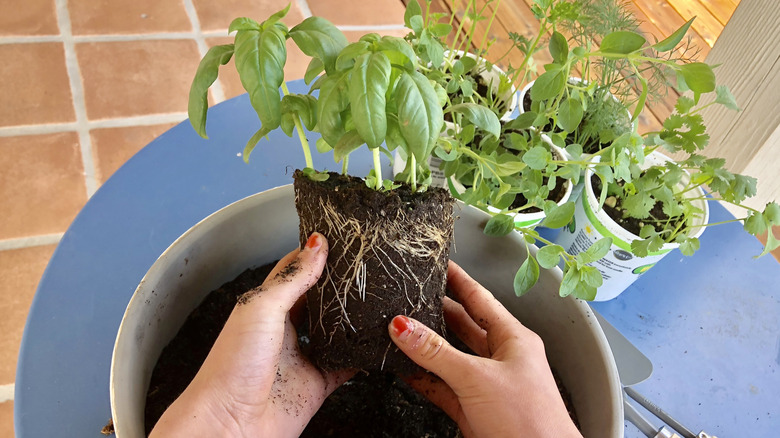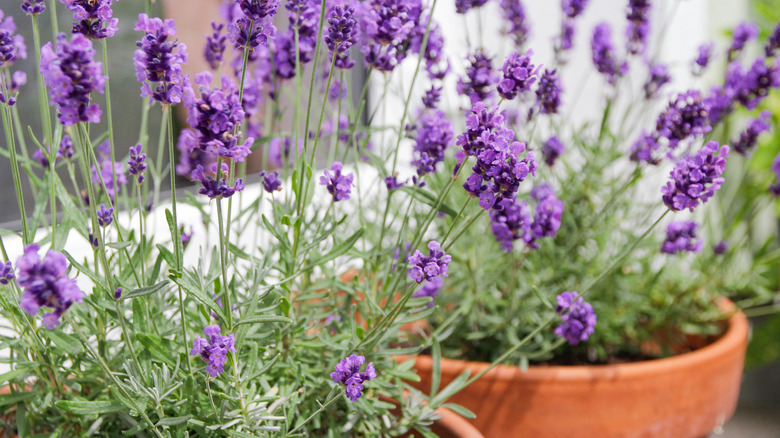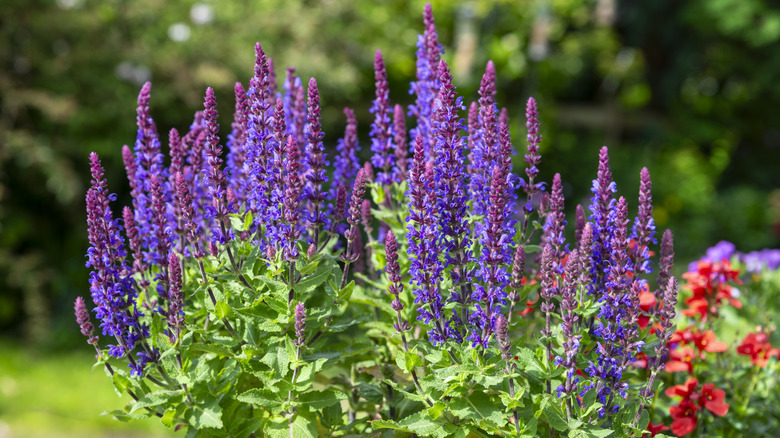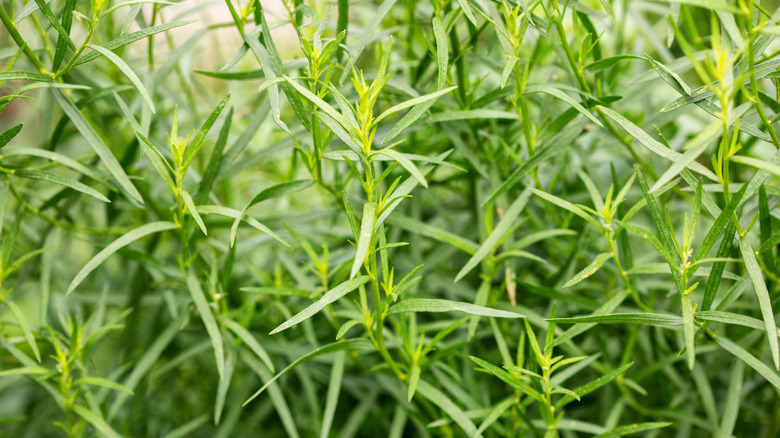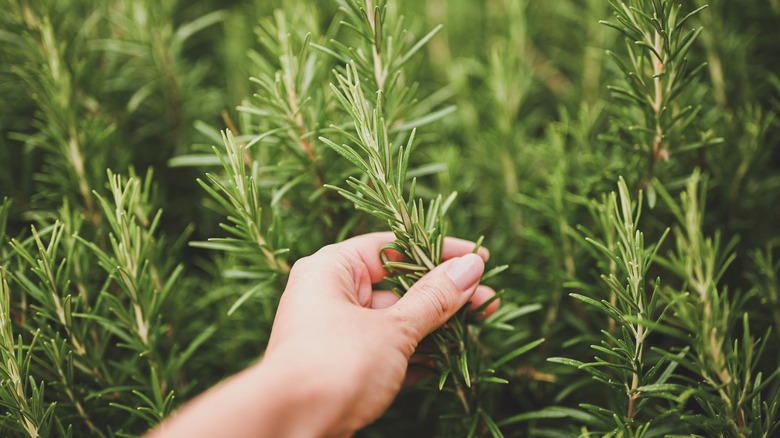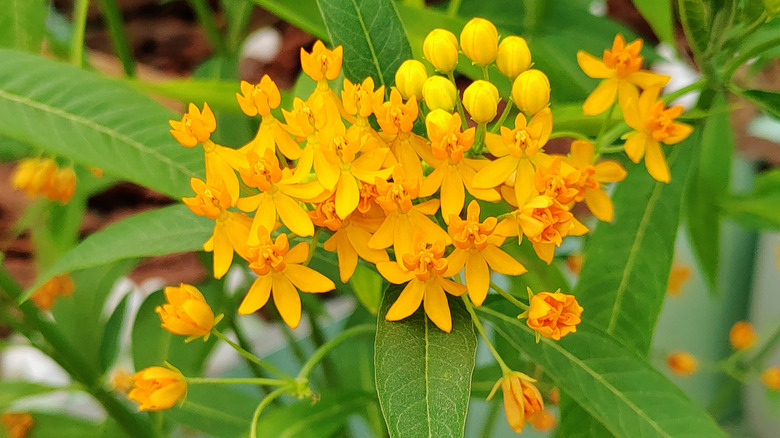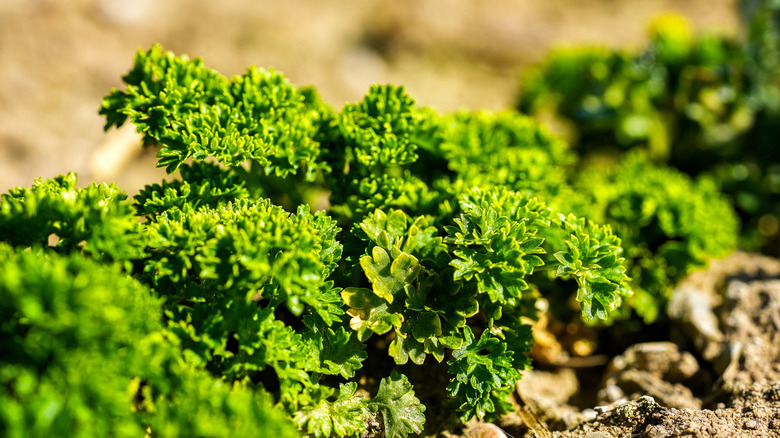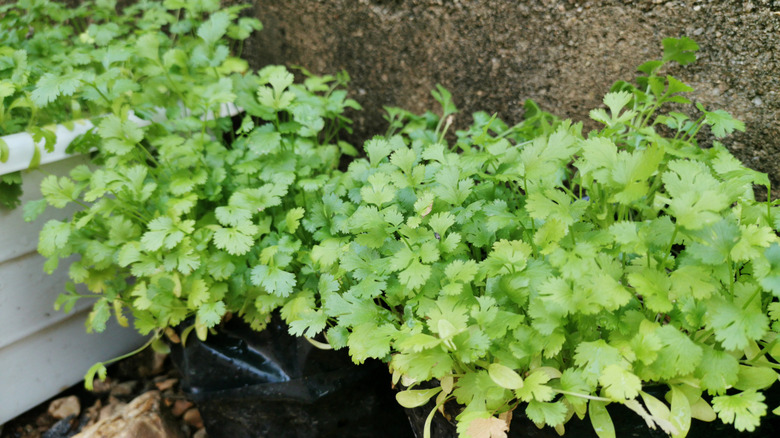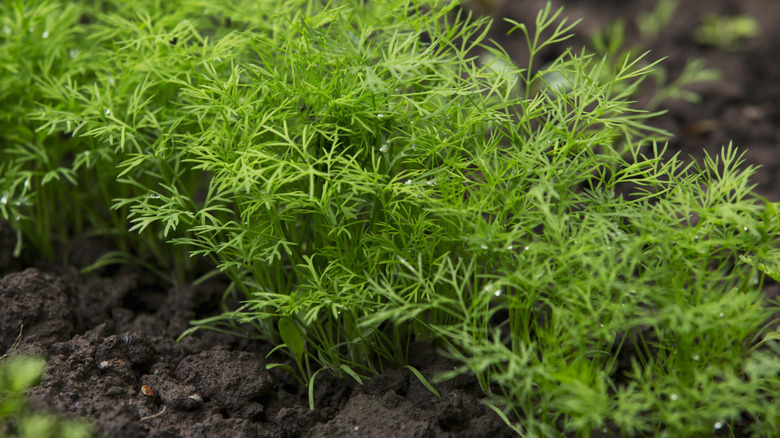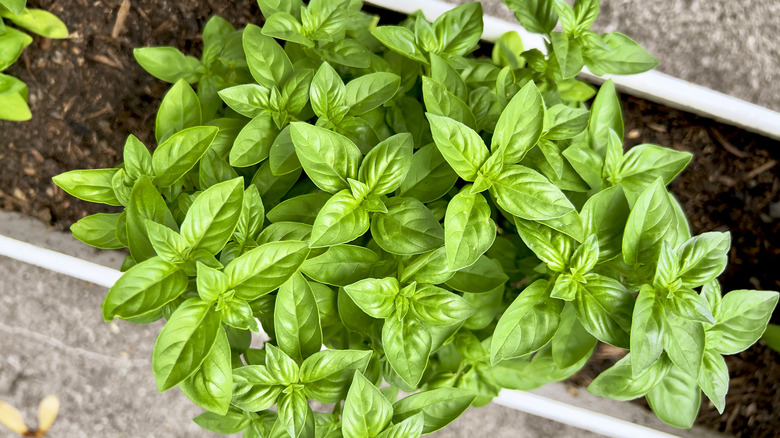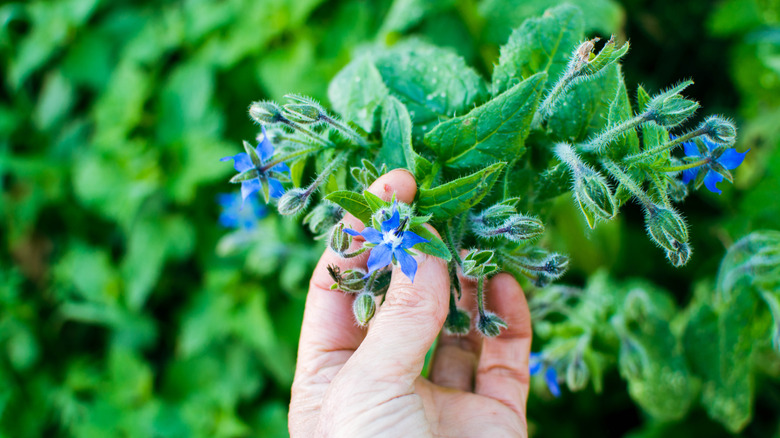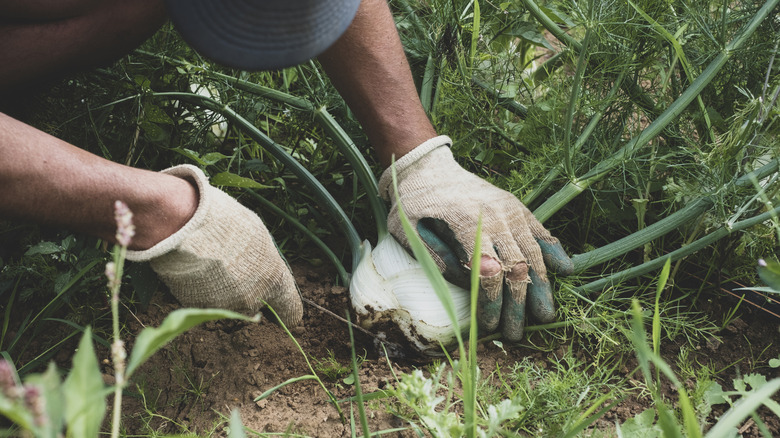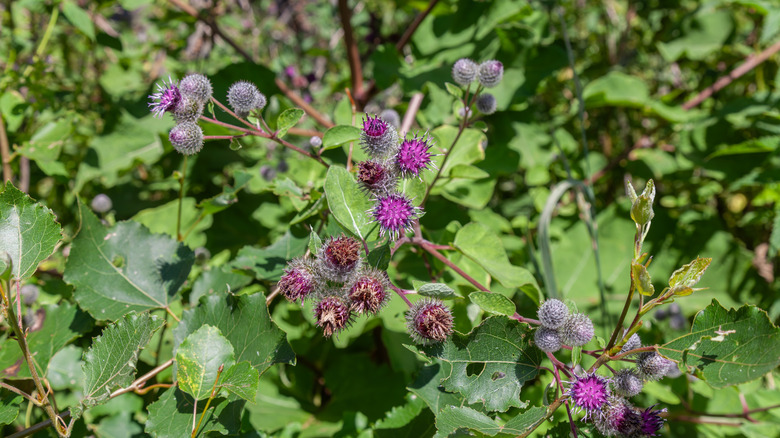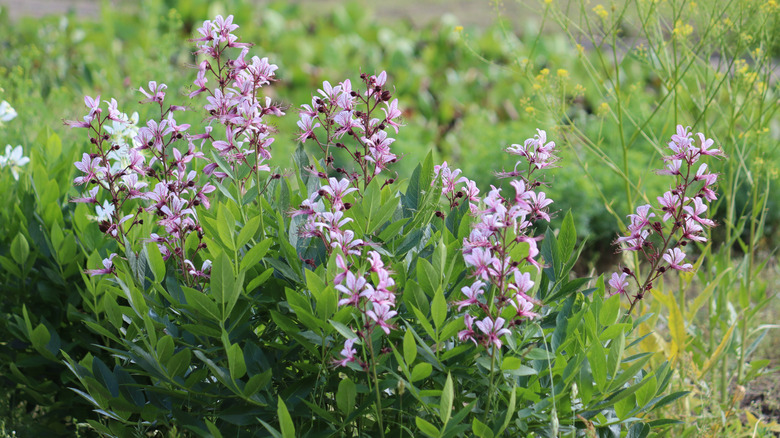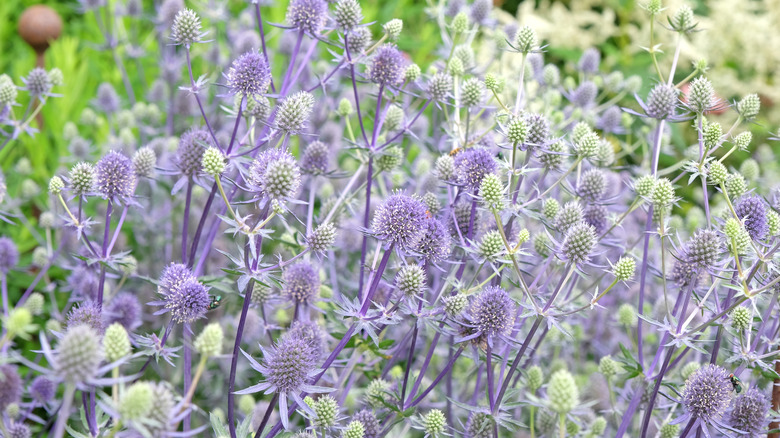Avoid Dividing These 14 Herbs At All Costs
Dividing herbs — that is, the practice of splitting up a large plant into smaller plants — is a great way to maintain the health of these garden staples. It's particularly important if a prolific grower starts taking over your yard. Basil, the easiest herb to grow for beginners and perfect for kitchen counters, is a prime candidate for division. The practice gives your plants a fighting chance by creating space for healthy root, stem, and leaf growth. Division is also a good way to spread the herby wealth to other spots in the garden. However, not all herbs enjoy division; in fact, some varieties downright hate it and can even die in the process.
Some herbs, especially woody-stemmed plants or those with deep taproots, don't fare well when divided. Their fussy, delicate root structures are compromised during the division and transplanting process. Lavender, rosemary, and sage are considered woody herbs, while herbs with taproots include fennel, cilantro, and dill, among others. Often, the roots in either type of plant don't survive the stress of being pulled apart and replanted. Thus, it's best to leave these herbs wherever they are growing, no matter how tempting it may be to split them up when they grow large.
Lavender
Lavender (Lavandula spp.), a perennial hardy in Zones 5 to 11, is one of those woody herbs that don't divide well. It has a tough root system and surprisingly fragile crown. Attempting to pry apart the plant damages the root ball, leaving insufficient systems behind to support the separated sections. This lack of viable roots, as well as transplant shock, typically leads to the death of divided plants. If you'd rather not be disappointed by suddenly wilted lavender and not getting the most out of its potential 3-foot growth, consider propagating new plants from cuttings instead.
Sage
Sage (Salvia officinalis) is a perennial herb that can grow up to 2½ feet tall and is hardy in Zones 4 to 1. It dislikes being divided because, similarly to lavender, it's a woody shrub. Expert gardener and Seedtime co-founder, Edwin Dysinger, tells Martha Stewart: "Once established, it does not like to be disturbed. It can be propagated by seed or cutting, but cutting is probably the easiest and best method." If you want multiple sage plants, it's best to heed the advice of the pros and gather cuttings for propagation or grow sage from seed.
Tarragon
Tarragon (Artemisia dracunculus var. sativa) is another woody perennial and it's hardy in Zones 3 to 8. Though it's tasty in dishes, the downside of tarragon is that it rarely produces viable seeds, making propagation by seed unreliable. Propagation from stem cuttings and root division are the only choices left to gardeners, but the latter method often fails. Tarragon roots are easily-damaged and brittle. The herb can reach heights of 2 to 3 feet with a 12 to 15 inch spread. If you want to thin your plant, cut it back and replant the sprigs rather than dividing it.
Rosemary
Rosemary (Rosemarinus officinalis or Salvia rosmarinus) is a perennial plant hardy in Zones 8 to 10. Like other woody herbs, it suffers when divided and relocated. Its multi-stemmed growth and deep root system make it difficult to split without disturbing the root ball. Thus, you run the high risk of killing the herb. The best way to grow rosemary is to be intentional with its location from the start. Find a spot in your garden that will facilitate a healthy root system without stressing the plant.
Butterfly weed
Butterfly weed (Asclepias tuberosa) is considered one of the gardening world's prettiest pollinators — but it comes at a cost. It's challenging to enjoy a beautiful butterfly weed garden without it taking over. Given its propensity for spread, it makes sense that you might want to thin your plant out. However, butterfly weed will likely not survive the process. It has a large, deep taproot that doesn't like to be disturbed once established. Butterfly weed is hardy in Zones 3 to 9, grows up to 3 feet tall, and spreads just as much.
Parsley
Parsley (Petroselinum crispum) is a delicate and short-lived herb, which makes it difficult to divide. Individual plants also grow from a single taproot, like carrots, that's particularly sensitive to disturbance or relocation. Disrupting the root sends shock waves through the plant, resulting in death in some cases. It's best to start new parsley plants from seed (or allow it to self-seed) or cuttings rather than through division. Hardy in Zones 2 to 11, it's otherwise relatively easy to grow and care for your own parsley plant.
Cilantro
Cilantro (Coriandrum sativum) also doesn't like division because it's a fast-growing annual with a long taproot. The aromatic herb suffers from transplant or relocation shock, similarly to parsley and rosemary. In fact, root trauma may cause cilantro to wilt, discolor, or grow stunted. As a survival mechanism, the plant can also bolt (known as going to seed) early and taste bitter. It's best to grow cilantro, hardy in Zones 2 to 11, from seed if you want more of it.
Dill
Dill (Anethum graveolens) is another victim of taproot trauma if subjected to division. The process can damage the plant's main root for nutrient transport. Dill can also experience transplant shock after being divided and replanted, which cuts the plant's life short and robs your table of a tasty herb. As with other herbs with fussy root systems, it's best to grow dill from seed if you want more in your garden. If well cared for, this herb, hardy in Zones 2 to 11, has the potential to grow up to 4 feet tall.
Basil
It's not a strict no-no to divide basil (Ocimum basilicum) — in fact, propagation by splitting or cuttings is often recommended. However, it's best not to attempt division if you're new to herb-growing. Dividing basil requires lots of skill and attention. You have to carefully and gently remove the entire plant, roots and all, from its pot or the ground. Once you've extracted the herb, you need to tease apart the root ball with your fingers, splitting it into smaller clumps, ready for re-planting. If you're a clumsy gardener or a novice, steer clear of the process or risk killing your plant.
Borage
Borage (Borago officinalis), also commonly called starflower, is a hardy annual herb that's known for its mild cucumber-esque flavor and medicinal uses. Given the plant's versatility, it's no surprise that gardeners are eager to grow more. Unfortunately, it's a herb that's best left undisturbed as an individual plant. Borage has a large, fragile taproot that's not a fan of division and transplanting. Attempt to break apart and move the plant and it will likely die. Instead, it's best to sow seeds directly into the garden.
Fennel
Related to carrots, fennel (Foeniculum vulgare) has the singular taprooted crown that's a hallmark of the family. It's just as sensitive as its similarly rooted cousins, too, and its underground parts dislike being disturbed once established. Grow new fennel plants from seed, as you would parsley and dill, rather than rely on the division. Take good care of your resulting plants, and the herb will reward you with up to six feet of growth in Zones 4 to 9.
Burdock
Burdock (Arctium lappa), a weedy biennial herb, grows to almost 10 feet and has a fleshy taproot that's sometimes used in drinks and herbal medications. This tough taproot makes division ill-advised, and instead reproduction by seed is your best bet if you want new plants. However, given burdock's ability to spread aggressively in Zones 3 to 10, you likely won't even have to consider division. If the flowers are allowed to mature, the seeds will stick to anything that passes by, spreading far and wide. You'll have new burdock plants popping up all over your garden in no time.
Dittany
Dittany (Dictamus albus), also commonly called burning bush or gas plant, is a bushy perennial herb. Popular with pollinators, the plant can grow 3 feet in height and spread almost 2 feet. It prefers to settle into a spot in the garden and doesn't transplant well. Division after establishment is, therefore, not recommended. It's best to propagate dittany from seed. However, it's a long game. Dittany seeds need a period of cold to sprout and take up to four years to flower.
Sea holly
You've likely identified the pattern: Herbs related to carrots with taproots don't divide well. Sea holly (Eryngium planum), an uncommon herb hardy in Zones 5 to 9 that grows up to 3 feet tall, falls into this category. Historically, the plant has been used for various medicinal and culinary purposes. It's attractive to today's gardeners due to its high tolerance for poor soils and good deer resistance. However, its stiff, clumping growth makes it difficult to parse out plants for division without disturbing the roots. Plus, it has spikes, making division a physical challenge for even the most determined gardener.
